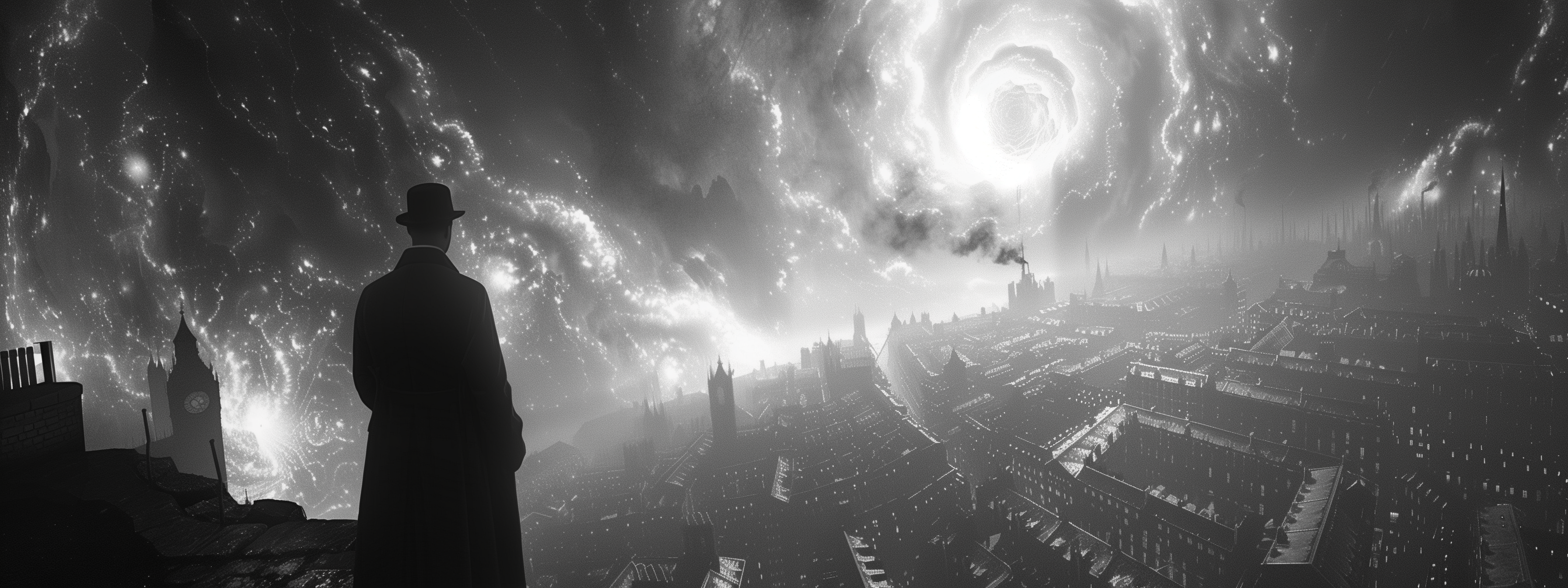The air was heavy with the scent of tobacco smoke and intrigue as you entered the Baker Street sitting room, where Sherlock Holmes sat, his keen eyes fixated on a series of peculiar diagrams spread across the table. Holmes was in one of his more pensive moods, and it was not the scene of an ordinary crime scene that demanded his attention today. No, the enigma before him was a crime against comprehension itself, one of natural order rather than law—a puzzle that confounded even the sharpest of minds: the mystery of irreducible sophistication in biological systems.
“Watson!” he exclaimed, leaning forward in his armchair, his eyes glinting with the thrill of discovery. “Do you see, my dear fellow, what lies at the heart of this puzzle?”

You too approached, peering over his shoulder at a bewildering diagram depicting an intricate cellular structure—a molecular machine, if ever there was one, composed of countless interlocking parts, each essential to the whole. It resembled, in its own biological way, the great mechanical wonders of our time—a product not of clockwork, but of life itself. And yet, like the most sophisticated parts, if even one cog were missing, the entire mechanism would fail. The concept was elegant, but fiendishly perplexing.
“Are we examining the handiwork of Nature, Holmes?” Watson ventured, feeling somewhat adrift in the sea of scientific complexity.
Holmes let out a low chuckle, steepling his fingers as he gazed at the diagram. “Indeed, Watson, but not merely that. We are peering into a riddle that challenges the very understanding of how such intricacies could come to be. Look here,” he pointed to a diagram of a flagellum—a minuscule whip-like appendage that powered certain bacteria through the body. “This structure—observe the rotor, the stator, the precise assembly of protein components—functions not unlike a human-engineered motor. It is sophisticated, irreducibly so. Remove but a single piece, and the entire operation is for naught.”

He paused, leaning back, the ghost of a smile playing across his lips. “And that, my new friend, is the essence of the case: How does something like this evolve piece by piece, each necessary for the whole, when no less than perfect unity is required for function? Imagine, if you will, a monkey sitting at a typewriter. The probability of such a creature randomly typing out the complete works of Shakespeare is infinitesimally small—virtually impossible in any practical sense. And yet, this is the kind of chance event we are asked to believe brought forth such intricate structures.”
Holmes paused, then continued, “Consider also the example of a cipher lock. If one were to attempt opening it by guessing, the odds are astronomical—millions of possible combinations, each as unlikely as the next. But imagine, Watson, if one knew that the code was based on something meaningful, such as the date of an eldest daughter’s birth. Suddenly, what seemed an impossible task becomes quite straightforward. This, Watson, is what we face: an arrangement of parts so precise, so interdependent, that the odds of its assembly by mere chance are as improbable as cracking a cipher lock at random.”
He gave me a long, considering look. “Therein lies our suspect: randomness and natural selection, working in concert. But does their union truly suffice to explain this arrangement, or is there an intelligence at work—some grand architect that has, unseen, been orchestrating this exquisite complexity?”
“You mean to suggest,” you said slowly, “that this is evidence—“
Watson raised a hand. “Evidence, yes, but proof remains elusive, Holmes.“
The joy of this investigation lies in unravelling what is hidden—a crime scene where every molecule is a clue, every protein an alibi or an accomplice.” Sherlock stood suddenly, pacing before the window, the London fog swirling just beyond. “Nature has secrets, Watson, secrets buried in the very building blocks of life. But consider—when we examine a watch, we instinctively recognize design, purpose. Why then should such discernment fail us when the mechanism is biological rather than mechanical?”

I watched as Holmes returned to his diagrams, his gaze sharpened like that of a hawk circling its prey. He tapped the page with a knowing finger, his eyes filled with that unmistakable sparkle—the thrill of unearthing truth where others saw only an opaque, impenetrable fog.
“Come, Watson,” he declared, his voice resolute. “The game is afoot. Whether Nature herself is the ultimate artisan or if there lies something—or someone—guiding her hand, we shall not let this mystery remain unsolved. Irreducible sophistication may not be beyond reason’s grasp—and today, we shall endeavor to grasp it.”
The evidence is available to you and a full collection will be provided to you collected after years and years of seeking the truth. Stay tuned for the kaleidoscope of information that any reasonable and thoughtful interrogation would reveal that the Mystery hidden has most certainly been revealed.

